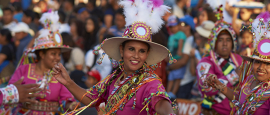Bolivia Weather, climate and geography
Weather & climate
Bolivia has a temperate climate but temperatures can differ dramatically between day and night. The wettest period is November to March, which, in extreme circumstances, may induce landslides in mountainous areas, and cause certain roads to become impassable. The northeast slopes of the Andes are semi-tropical. During the wet season the salt flats become flooded – it is a beautiful spectacle, as the flats turn into a mirror of the sky above. Winter is perhaps the best time to visit (May-October), especially in the hot and humid lowlands, as it is cooler and drier. In the highlands, it rains much less, remains sunny through the day but gets noticeably colder at night. Visitors sometimes find the highlands (especially La Paz) uncomfortable because of the thin air due to high altitude. The mountain areas can become very cold at night.
In terms of clothing, lightweight, natural fabrics and waterproofs are best. Layering is a good idea if taking the tour of the salt flats – it’s extremely cold at night and early mornings, but when the sun comes out it warms up quickly. Warmer clothing is necessary at night in the Altiplano, especially in La Paz, Oruro and Potosí. If you need warm clothing, the markets of La Paz and Sucre are a good place to find alpaca wool jumpers and scarves.
Geography
Landlocked by countries (Argentina, Brazil, Chile, Paraguay and Peru), Bolivia is a topological pick and mix of spectacular sights, and remains one of the most bio-diverse countries in the world, despite not having a coast. The geography is largely split into the Andean Altiplano and the Eastern lowlands, and the contrast between them could not be greater. In the West, the parallel mountain chains of the Andes dominate. There’s everything from deserts strewn with cacti and soaring rock formations, to magical coloured lakes and the world’s largest salt flat, which contains 10 billion tonnes of salt (the remnants of Lake Minchin which evaporated some 25,000 years ago). You can see llama, alpaca, vicuñas (rabbit-like animals), puma, and the only bear species in South America at these heights. On top of that, expect volcanic geysers at over 4000m (13,000ft) above sea level, the world’s highest lake and the world’s highest capital, La Paz, which sits in a mountain valley with the looming Mount Illimani looking over. The high altitude can take its toll on travellers, so come prepared.
Eastern Bolivia is like a completely different world. The Amazon offers all types of flora and fauna, from over 30 monkey species and giant armadillos to catfish, piranha and pink freshwater dolphins. Visit Rurrenabaque to take tours of the Río Tuichi, the Parque Nacional Madidi and the Pampas del Yacuma. The green tropical lowlands of Santa Cruz offer tropical cloudforest – try the Parque Nacional Amboró for lush beauty. The Pantanal, on Bolivia’s eastern border with Brazil is the world’s largest wetland. Over 200,000 sq km (77,000 sq miles) of ecosystems live here, including swamps, lakes, flooded freshwater grasslands and forest. It is here that you will also find the highest concentration of fauna in all the Americas – birds, anacondas and giant otters to name a just a few.
Do you have any Feedback about this page?
© 2025 Columbus Travel Media Ltd. All rights reserved. No part of this site may be reproduced without our written permission, click here for information on Columbus Content Solutions.




 You know where
You know where